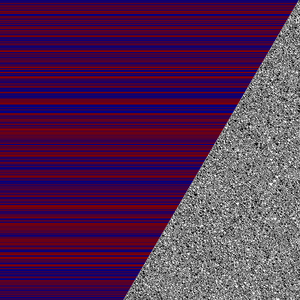Antihydra: Difference between revisions
→Simulation: Fix simulation random walk bound |
Add visualization of the evolution of the Antihydra's "a" variable in binary representation |
||
| Line 51: | Line 51: | ||
== Analysis == | == Analysis == | ||
[[File:Antihydra increasing value.png|thumb|Binary representation of the first 1000 steps of the evolution of the exponentially increasing variable of the Antihydra iteration (a = a + a//2), the colored background indicating whether the value is even (blue) or odd (red)]] | |||
Let <math>A(a+4, b) = 0^\infty \; 1^b \; 0 \; 1^a \; E> \; 0^\infty</math>, then<ref>S. Ligocki, "[https://www.sligocki.com/2024/07/06/bb-6-2-is-hard.html BB(6) is Hard (Antihydra)]" (2024). Accessed 22 July 2024.</ref> | Let <math>A(a+4, b) = 0^\infty \; 1^b \; 0 \; 1^a \; E> \; 0^\infty</math>, then<ref>S. Ligocki, "[https://www.sligocki.com/2024/07/06/bb-6-2-is-hard.html BB(6) is Hard (Antihydra)]" (2024). Accessed 22 July 2024.</ref> | ||
Revision as of 21:41, 3 March 2025

Antihydra (1RB1RA_0LC1LE_1LD1LC_1LA0LB_1LF1RE_---0RA (bbch)) is a probviously nonhalting BB(6) Collatz-like Cryptid. In fact, it was the first identified BB(6) Cryptid. It is closely related to Hydra.
It simulates iterations of the Collatz-like Hydra function:
starting from 8:
Antihydra halts if and only if the cumulative number of odd values in this sequence is ever more than twice the cumulative number of even values.
If we treat the parity of successive values in this sequence as independent random coin flips, then this is a biased random walk and has a miniscule chance of ever halting, thus we say that this TM "probviously" does not halt. But proving this would require solving a Collatz-like problem.
Turing Machine
Antihydra is the TM 1RB1RA_0LC1LE_1LD1LC_1LA0LB_1LF1RE_---0RA (bbch)
| 0 | 1 | |
|---|---|---|
| A | 1RB | 1RA |
| B | 0LC | 1LE |
| C | 1LD | 1LC |
| D | 1LA | 0LB |
| E | 1LF | 1RE |
| F | --- | 0RA |
It was discovered by @mxdys on 28 Jun 2024 and shared on Discord[1] and Racheline discovered that it iterates the Hydra function.
Analysis

Let , then[2]
At each iteration, and
halting iff b ever reaches -1.
Biased Random Walk
If we consider the sequence of parities of to be independent random coin flips, then the movement of is a biased random walk (50% chance of +2, 50% of -1). Starting from , the chance of such a random walk ever reaching is and the expected value of b after k steps is .
Simulation
@mxdys has simulated this iteration out to steps at which point (Discord link), this is 20940 (0.002%) below the expected value if this were a random walk. If this was a random walk, the chance of ever halting from this point is
an extremely miniscule chance.
Sources
- ↑ Discord message, accessed 30 June 2024.
- ↑ S. Ligocki, "BB(6) is Hard (Antihydra)" (2024). Accessed 22 July 2024.